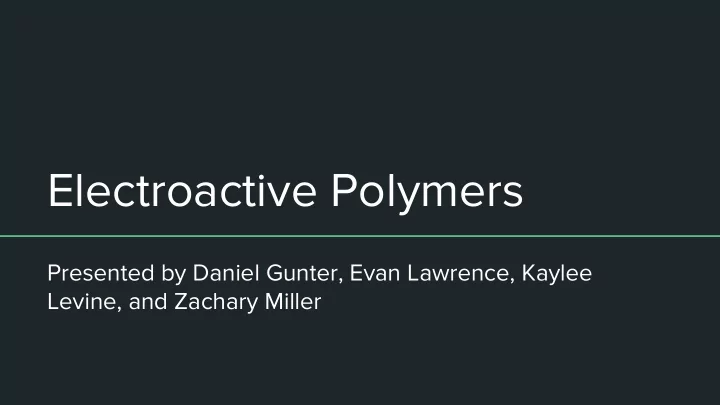

Electroactive Polymers Presented by Daniel Gunter, Evan Lawrence, Kaylee Levine, and Zachary Miller
Biological Muscles Definition of an actuator: device that ➢ converts input energy into mechanical energy Muscles as actuators ➢ ○ Resilient ○ Flexible ○ Large forces ○ Sleek Muscles: a longtime subject of scientific interest ➢ ○ “Animal electricity” Luigi Galvani, 1792 Role of Ca 2+ ○
Artificial Muscles Biomimicry: the imitation of natural biological designs or processes ➢ 1670s: Robert Hooke ➢ Polymers ➢ ○ Lightweight, cheap, flexible Response to stimuli ○ Electroactive polymers ➢ ○ Large deformation for small input ○ 1990s: major breakthroughs “[EAPs] will enable faster implementation of science fiction ideas into engineering reality.” -Yoseph Bar-Cohen
Future Applications Biomimetic robots ➢ Exoskeletons ➢ Unmanned aerial vehicles ➢ (https://www.youtube.com/watch?v=XoyA_w0DDDc) Space ➢ (https://www.youtube.com/watch?v=6cdfWdHZRrE)
Applications Linear Actuators ➢ Several layers of dielectric elastomer sheets wrapped around a spring. Called a spring roll ○ ○ Voltage causes the film of sheets to squeeze in thickness while relaxing in length, causing the roll to extend. ○ Applications in prosthetics and automation.
Applications Bending Actuators ➢ Electrodes are attached at various locations along circumference of Spring Roll ○ ○ Voltage causes these locations to extend, causing the entire roll to bend away Applications in steerable medical catheters ○
Applications Push-Pull Actuators ➢ Spring Rolls configured to work against each other ○ ○ Transferring voltage from one roll to the other can shift the position of the device back and forth Similar to the opposing bicep and tricep muscles that control movement in the human arm ○ ○ Applications in prosthetics Sensors ➢ ○ All dielectric elastomer devices experience a change in capacitance when they deflect. ○ When calibrated, this change in capacitance can be used as a sensor. ○ Can be incorporated into fabrics, fibers, strips, or coatings. ○ Application in seat belt sensors
Applications Energy Harvesting Devices ➢ All dielectric elastomer devices experience a change in capacitance when they deflect. ○ ○ This change can be manipulated through the use of electronics and produce usable electrical energy. ○ Applications for the military and other serviceman such as Policeman and Firefighters. Surface Texturing ➢ ○ Sheets of polymers are coated with patterns of electrodes with dots attached to them. ○ The electrodes are stimulated, causing the dots to be raised to varying heights. ○ Applications in “active camouflage” and improving aerodynamic characteristics of moving objects.
Ionic EAP Types and Theory https://en.wikipedia.org/wiki/Ionic_polymer%E2%80%93metal_composites https://www.cambridge.org/core/services/aop-cambridge-core/content/view/090016905913EB7D9A0FB791F2B325B8/S088376940000 Ionic Polymer Metal 4590a.pdf/carbon_nanotube_electroactive_polymer_materials_opportunities_and_challenges.pdf Carbon Nanotubes Composites ● 3 layer w/ Polyelectrolyte Rolled Sheets ● ● Physically Coated or ● C-C Bond Chemically Plated Interactions electrodes ● 30 V → 1500 nm ● 100 Hz
Ionic Polymer Gels ● Oscillations between Acidic and Alkaline ● Two Bending Types ● Deflections ~0.84 http://iopscience.iop.org.pitt.idm.oclc.org/article/10.1088/0964-1726/20/4/045006/pdf Conductive Polymer ● Doping ○ P-type ○ N-type ● Band Travel ● 40 Hz Electrorheological Fluid ● Liquid → Gel 0.1-100 µm ● https://www.mdpi.com/2076-0825/4/3/135 https://www.intechopen.com/books/smart-actuation-and-sensing-systems-recent-advances-and-future-challenges/simultaneous-smart- actuating-sensing-devices-based-on-conducting-polymers
Electronic EAP Theory https://en.wikipedia.org/wiki/Piezoelectricity Piezoelectric Polymers ● Electric Charge → Mechanical Stress ● Powerful and Precise ● Semi-Crystalline https://www.youtube.com/watch?v=hsd7_vQqt5w
https://www.sciencedirect.com/science/article/p ii/S0924424714004488 http://www.electricalbasicprojects.com/what-is-hysteresis-loss-hysteresis-loop/ Liquid Crystal Elastomers Ferroelectric Polymers ● Nematic → Isotropic ● Reversible ● Temperature Affects Order ● High E Values ● Strains of 400% ● Hysteresis Loop
Fabrication Lack of established fabrication processes ➢ CNT’s use are widespread and thus have more concrete methodologies ➢ Extensive Lab procedures create highly controllable results ➢ DIY low resolution EAP ➢ ○ “Fun” activity ○ Not highly controllable
IPMC: Dr. - Orguro Osaka National Research Institute Prepare surface ➢ ○ Sandblasting and washing Ion Exchange via immersion in metal complex ➢ Primary Plating via immersion → layers of metal appear on surface ➢ Secondary Plating dependent on success of Primary Plating ➢ Heavily controllable process ➢ Concentrations are described very specifically ○
DIY EAP Using inexpensive and dry materials
References WW-EAP Fabrication Recipes. (n.d.). Retrieved from https://ndeaa.jpl.nasa.gov/nasa-nde/lommas/eap/EAP-recipe.htm Mohsen Jahanshahi and Asieh Dehghani Kiadehi (May 9th 2013). Fabrication, Purification and Characterization of Carbon Nanotubes: Arc-Discharge in Liquid Media (ADLM), Syntheses and Applications of Carbon Nanotubes and Their Composites, Satoru Suzuki, IntechOpen, DOI: 10.5772/51116. Electroactive Polymers. (n.d.). Retrieved from http://materiability.com/portfolio/electroactive-polymers-diy/ Wang, Qing Ming. (2017). Lecture 1: Introduction and Transducer Models . University of Pittsburgh. http://www.pitt.edu/~qiw4/Academic/MEMS1082/Lecture1.pdf Martonosi, Anthony N. (July 20, 2000). “Animal electricity, Ca2+ and muscle contraction. A brief history of muscle research.” Acta Biochimica Polonica, Volume 47 (No. 3), 493–516. “What is Biomimicry?” Biomimicry.org. https://biomimicry.org/what-is-biomimicry/ Brinson, Hal F., & Brinson, Catherine L. (2008). Polymer Engineering Science and Viscoelasticity: An Introduction. Retrieved from https://link.springer.com/content/pdf/10.1007%2F978-0-387-73861-1.pdf The Uses of the Future in Early Modern Europe (Eds: A. Brady, E. Butterworth), Routledge, New York 2009. Huang, Gregory T. (December 1, 2002). “Electroactive Polymers.” MIT Technology Review. https://www.technologyreview.com/s/401750/electroactive-polymers/#comments Bar-Cohen, J. (2004). Bellingham, WA: SPIE
Recommend
More recommend